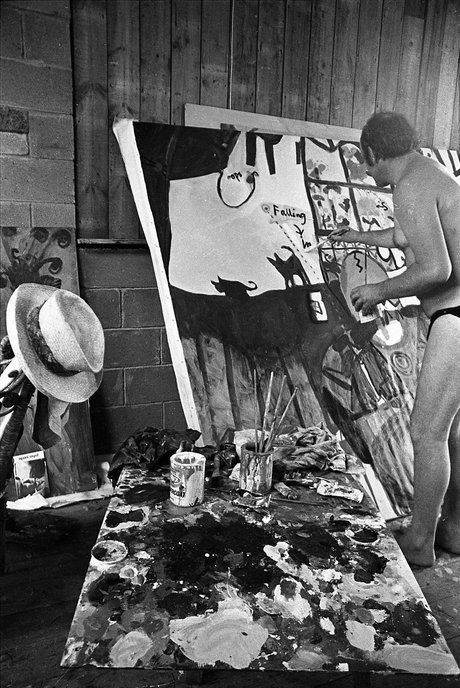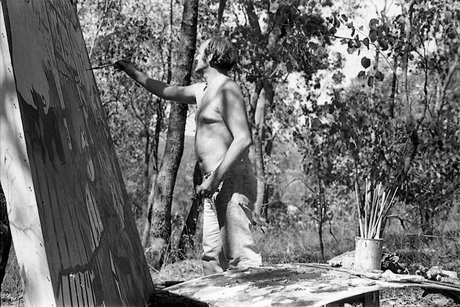John Olsen
Australia, England, Spain, Portugal
Born: Newcastle, New South Wales, Australia 21 Jan 1928
Died: 11 Apr 2023

Portrait of John Olsen painting Love in the kitchen (now in a private collection) at Dunmoochin, Victoria in 1969, by Robert Walker © Estate of Robert Walker. Source: Art Gallery of New South Wales Archive
Biography
John Olsen is one of Australia’s most celebrated artists. In a career spanning more than seven decades, he created a unique vision of the spirit and character of this country. He developed an exceptional and distinctive pictorial language defined by energised lines and bold colour in works that meld both representation and abstraction. Olsen painted a personal view of the world as experienced by the senses, often full of joie de vivre but also contemplative and deeply felt.
Born in Newcastle, New South Wales, in 1928, Olsen wanted to be an artist from an early age. He began his formal art studies at the Dattilo Rubbo Art School in Sydney in 1947, aged 19. From 1950 he studied full-time at the Julian Ashton School under the Cézannesque painter John Passmore, and at East Sydney Technical College (now the National Art School) with Godfrey Miller.
The work of French postwar abstract artists (seen in the 1953 exhibition French Painting Today at the Art Gallery of New South Wales) and of the Italian moderns had a significant impact on Olsen. He held his first exhibition in Sydney in 1955 and by the end of 1956, when he travelled to Europe on a private scholarship, he was recognised as an emerging force in the Australian art world.
Between 1957 and 1960, Olsen visited London and Paris before settling in Spain, on the island of Majorca. Living outside the small village of Deià, he became alive to what he called ‘intensities of nature’ and was profoundly affected by the culture and culinary arts of the Mediterranean – a passion that continued throughout his life.
On his return to Sydney in 1960, Olsen painted the exceptional ‘memory-journey’ landscape Spanish encounter 1960. The work condensed his experiences of the Spanish village – its sounds, shapes, smells, sights and dark tonalities – and Sydney’s energetic city life, into a raw vision. It was immediately seen as a turning point in Australian art and purchased by the Art Gallery of New South Wales.
Olsen’s preoccupation with capturing his immediate responses to his environment brought him to great prominence in Australia in the 1960s. For much for the decade, his work focused on the Australian natural environment.
The You beaut country paintings – completed after Olsen’s sojourn in the old NSW mining town of Hill End in 1960 – have become one of his best-known series. At Hill End, Olsen said, ‘I could feel Australia … I found myself saying how “beaut” everything was’.
The You beaut country paintings incorporated geological, vegetative and anthropomorphic forms in a constant flux of birth, life and decay. With these radical new landscapes, Olsen expressed a sense of the irrationality of nature and the swarming, organic energies of the Australian environment.
Olsen was equally adept at painting the vitality of his urban environments. In major cityscapes, such as Entrance to seaport of desire 1964, Olsen used strong colour and graffiti-like surfaces to create some of the most memorable, and perhaps anarchic, paintings of the era. He visualised Sydney as a dynamic and voluptuous ‘siren city’ of chaotic streets, light, water, colour and noise.
Sydney Harbour inspired Olsen to create numerous paintings, the best known of which is Five bells 1963. Olsen used Kenneth Slessor’s great eponymous poem, written in 1939, as his starting point, to paint on large scale, and with calligraphic force, the sensations of the ebb and flows of the harbour. This work was a prelude to the monumental Salute to ‘Five bells’ 1972–73, commissioned for the northern foyer of the Sydney Opera House. Architect Jørn Utzon urged Olsen to create a work that would ‘become part of the harbour’. Olsen responded with a mural that extracts from the mysterious depths of the harbour that it faces.
In 1969, registering a ‘need to be in the landscape for a while’, Olsen moved to fellow artist Clifton Pugh’s property Dunmoochin at Cottles Bridge in Victoria. In this environment of ‘rolling dry hills with eucalyptus foliage’, Olsen allowed light, delicate colour and a new detailing to bathe his paintings as he confirmed the central place of the Australian landscape in his art.
Olsen first visited Lake Eyre (Kati Thanda to its Arabana custodians) in October 1974 and was introduced to the almost inhuman scape and space of the Australian interior – ‘a bowl of endless sky [to] a point of limitless nothing’. This had a cathartic effect on Olsen’s art. Over subsequent decades he made numerous trips to the region.
In 1973 the lake, normally a salt-encrusted wasteland abutting the Simpson Desert, was filling for only the second time since European occupation. Olsen witnessed its transformation into an immense inland sea teeming with birds, fish and insects. Later, as the waters receded, he watched the lake and its life disappear.
The vastness of this life–death cycle, and Olsen’s sense that ‘the full lake is entwined with the destiny of the empty lake’, catalysed a new spirituality in his art. Alive to various Zen and Taoist philosophies since the late 1950s, he saw Lake Eyre as ‘the void’ – a metaphor for the generative forces from which creation springs. These revelations brought a new lyricism to his art, in paintings crafted as part close-up habitat, part aerial view, part visual poetry.
Olsen’s close contact with Australia’s natural world took a new turn in 1971 when he was invited to join a film crew developing the Wild Australia series of documentaries focusing on Australia’s wildfire and habitats. It was from this time onwards that depictions of wildlife, including birds, frogs and sea-life, became more of a feature in his work.
Olsen emerged from his Lake Eyre experiences with a more contemplative line, expansive space and a pictorial lyricism. In the 1980s he experienced living in new environments, firstly on the plains of Wagga Wagga, NSW and then in the village of Clarendon, South Australia, where he settled for seven years from 1981.
In a group of rich yet restrained ‘landscape-abstracts’ such as Golden summer, Clarendon 1983, Olsen experimented with the oil washes applied over large canvases. These paintings and others based on his travels through remote north-west Australia were widely acclaimed.
Olsen continued to evolve artistically over the next two decades, painting from memory as well as from his experiences of new regions, such as the landscapes of the Northern Territory.
As he entered into old age, Olsen frequently used the idea of the self-in-landscape as a vehicle for his contemplation of mortality. In his austere Self portrait: Janus-faced, which won the Archibald Prize in 2005, he painted himself poignantly disappearing into the environment.
If such works have explored the shadow side of Olsen’s consistently celebratory art, he also continued to create exuberant new landscapes with all the joy, pulsating light and rhapsodic connection embodied in his earlier work.
In 1999 Olsen moved to a property in the Southern Highlands of New South Wales. He continued to work and exhibit regularly until his death in April 2023. His creative output was immense, and throughout his long career he retained an extraordinary passion for art and life.
Olsen was a trustee of the Art Gallery of New South Wales from 1976 to 1981. He won the Wynne Prize in 1969 and 1985 and the Sulman Prize in 1989, among many other awards throughout his career. He was awarded an Order of the British Empire in 1977 and an Order of Australia in 2001.
In 2016–17 a major retrospective, John Olsen: The You Beaut Country, was co-curated by the Art Gallery of New South Wales and the National Gallery of Victoria.











